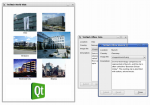
Qt provides extensive database interoperability, with support for products from both open source and proprietary vendors.
SQL support is integrated with Qt's model/view architecture, making it easier to provide GUI integration for your database applications.
| Shows how to use Qt SQL classes with a model/view framework | |
| Cached Table example shows how a table view can be used to access a database, caching any changes to the data until the user explicitly submits them using a push button | |
| Drill Down example shows how to read data from a database as well as submit changes, using the QSqlRelationalTableModel and QDataWidgetMapper classes | |
| Master Detail Example shows how to present data from different data sources in the same application. The album titles, and the corresponding artists and release dates, are kept in a database, while each album's tracks are stored in an XML file | |
| Query Model example shows how to make customized versions of data obtained from a SQL query, using a model that encapsulates the query and table views to display the results | |
| Relational Table Model example shows how to use table views with a relational model to visualize the relations between items in a database | |
| SQL Browser example shows how a data browser can be used to visualize the results of SQL statements on a live database | |
| SQL Widget Mapper example shows how to use a map information from a database to widgets on a form | |
| Table Model example shows how to use a specialized SQL table model with table views to edit information in a database |
Examples marked with an asterisk (*) are fully documented.